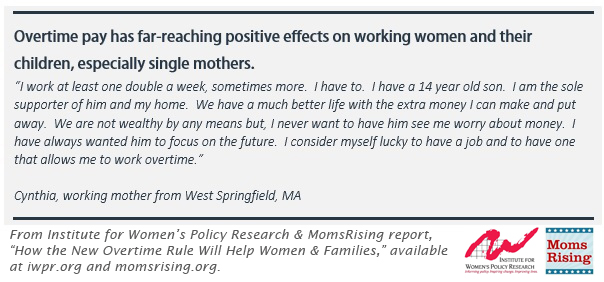by Jennifer Clark
Today, the U.S. Department of Labor (DOL) issued its long-awaited final rule on raising the salary threshold under which working people can earn overtime pay. The final rule will double the current salary threshold from $23,660 to $47,476, directly benefiting 12.5 million workers, according to estimates from the Economic Policy Institute. The rule is undoubtedly major progress for workers struggling to support their families at a decent standard of living, and especially for working women in the United States.
According to EPI, over half of the workers—6.4 million—who will directly benefit from the increased threshold are women. A report produced last year by the Institute for Women’s Policy Research and MomsRising also found that women of color and single mothers—groups that are especially economically vulnerable—will disproportionately benefit: under a slightly higher threshold, nearly half of currently exempt black and Hispanic women workers and working single mothers would gain coverage. (The analysis was based on the $50,440 threshold originally proposed by DOL; the final rule, set at a slightly lower earnings threshold, will likely show an even greater proportion of women of color and single mothers benefiting, as these groups tend to earn less than women overall.)

The final $47,476 was chosen because it represents the earnings of the 40th percentile of salaried workers in the South. Women are now the sole or co-breadwinner in half of American families with young children. In the South, half of all breadwinner mothers are women of color, with black mothers especially likely to be carrying the responsibility their family’s economic security. Four out of five black mothers in the South are breadwinners, compared with half of white and Hispanic mothers in the region. With over 2 million working mothers across the country newly covered under this final rule, more families, like Cynthia’s, can benefit from additional earnings or, if not obligated to work long hours with no extra pay, more time with loved ones.
For other women who have shared their stories with MomsRising, overtime pay has been the difference between making ends meet and choosing between paying for electricity at home or gas to get to work. While more still must be done to ensure women can make ends meet for their families without working overtime, the new rule gives millions of working women who work long hours already without compensation a little more breathing room.

With fair pay (at time and a half) for workers who work more than 40 hours per week now becoming a reality for so many women earning less than $47,476 per year, it’s time for policymakers to make paid family leave and equal pay realities as well—major steps that will also help to bring women and their families above poverty and toward a middle class living standard.
Read more stories and analysis in IWPR and MomsRising’s 2015 report, How the New Overtime Rule Will Help Women & Families.
Find updated estimates on how many workers will be affected under the final rule from the Economic Policy Institute.
Jennifer Clark is the Director of Communications at the Institute for Women’s Policy Research.
To view more of IWPR’s research, visit IWPR.org

